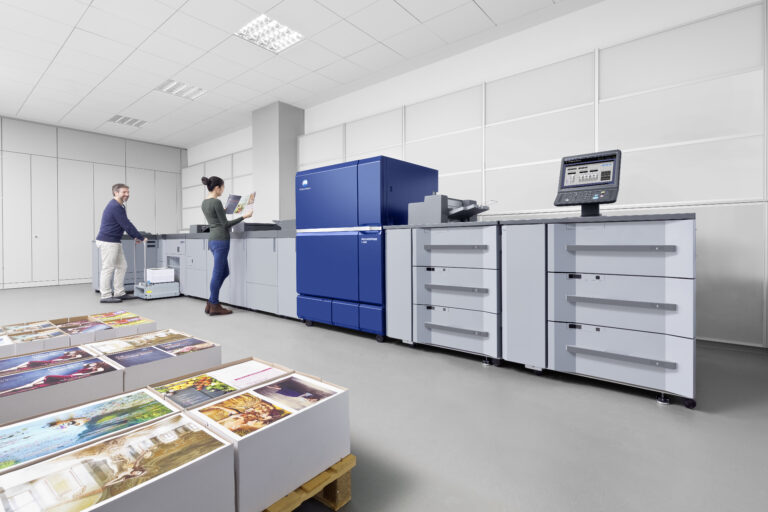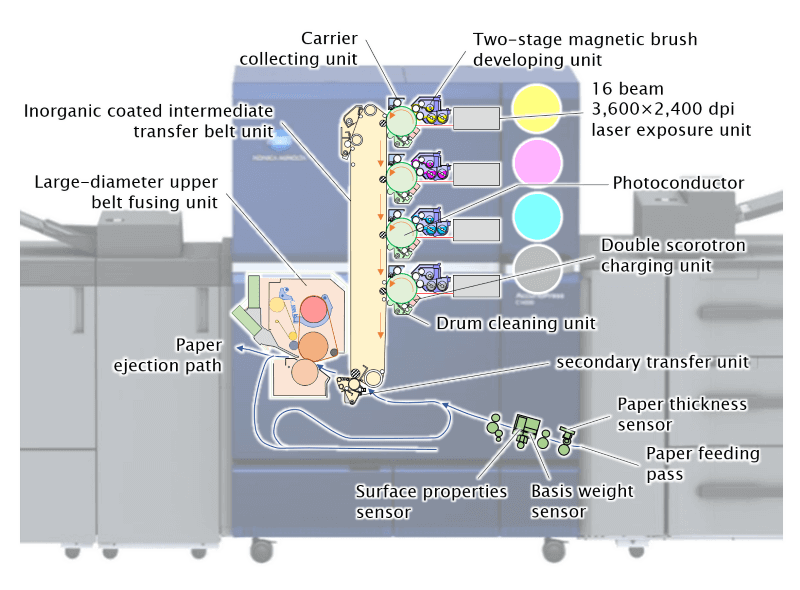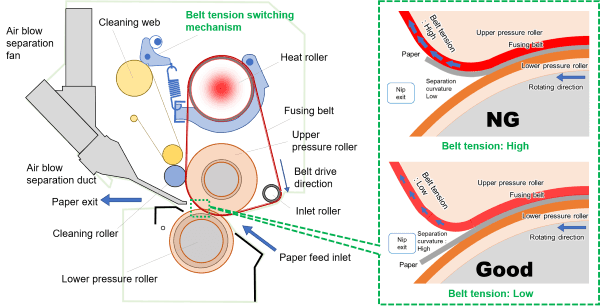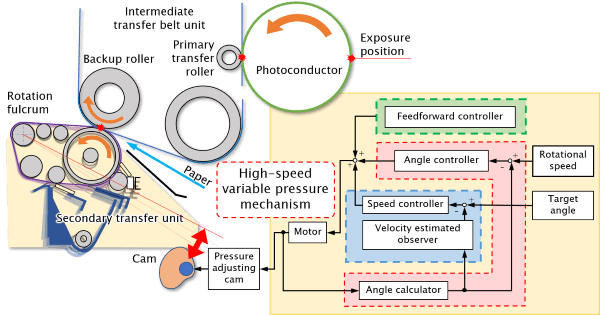Digital electrophotography processing technology that achieves both high productivity and image quality
Industry-leading quality achieved by outstanding design and development capabilities and detection and control technologies

\Our expert team handles inquiries
on technical partnerships and joint research./
Helping customers who require mass customization capabilities to succeed based on industry-leading productivity and expressivity thanks to outstanding image quality
Konica Minolta has developed the AccurioPress C14000 digital press with outstanding image quality and productivity to satisfy production print customers. The product reduces the working time from the pre-process of printing to post-process, including inspection, by automating the machine adjustment and inspection and improving the reliability of the imaging process. It helps customers improve their business productivity and focus on creative work. These new functions leverage the strengths of digital printing for small-lot short-delivery production: they minimize waste, delivery times, and human intervention required in the current supply chain, thus helping customers to succeed in rationalizing the production process and achieving mass customization. The functions also reduce the environmental impact of the entire supply chain.

The AccurioPressC14000 supports customers with superb quality and efficiency for various applications, including booklets, catalogs, cards, and envelopes.
Technology Overview
Konica Minolta’s digital color production printer offers a high space utility factor and minimizes the paper feeding path by using a proprietary vertical tandem configuration, in which imaging units of the respective colors (yellow (Y), magenta (M)), cyan (C), and black (K)) are stacked vertically. Konica Minolta designed the mechanism and developed devices based on its wealth of expertise in the characteristics and working principles of electrophotography, which is affected by changes in temperature and humidity and usage history. This stable and highly efficient imaging system has been built by deeply integrating detection and control technologies. The physical properties of various types of paper that are used in production printing are detected by multiple sensors, ensuring optimal paper feeding based on high-speed and high-accuracy driving control technology. These technologies offer high-speed printing of 140 sheets/min. (A4), the fastest in the industry for the flagship model.

Configuration of the imaging process of the AccurioPress C14000 with output of 140 sheets/min. (A4)
Two-component thin layer magnetic brush development unit for high image quality and speed
Two development rollers softly brush on photoreceptors to visualize electrostatic latent images with high fidelity.
In the development process to visualize an electrostatic latent image with toner, a high-image-quality development process has been achieved without brushing noise by using low-stress magnetic brush thin layer forming technology and Konica Minolta’s proprietary high-efficiency development technology. For the AccurioPress C14000, which has the fastest output speed in the industry, a new two-stage magnetic brush development unit has been developed by further improving the high-efficiency and high-image-quality design, thus raising both image quality and speed. A large-capacity, high-efficiency developer circulation and agitation mechanism has been newly designed. The AccurioPress C14000 is also equipped with a new developer level detection control mechanism to increase the reliability of the developer feeding mechanism and improve the robustness during usage for production printing, which includes both low and high coverage.
Two-component thin layer two-stage magnetic brush developing unit built into the AccurioPress C14000
Upper belt fusing system designed for optimal heating, pressurization, and separation
Basis weight range of paper feeding expanded to 52 – 450 g/m2

Upper belt fusing system equipped with belt tension switching mechanism for the AccurioPress C14000
In the fusing process in which powder toner is fixed on paper by applying heat and pressure, if the diameter of the fusing roller is increased to secure the heat and pressurization time required for fixing, the separation curvature at the fusing nip exit cannot be attained, resulting in separation failure of low-rigidity paper, such as thin paper. The upper belt fusing system ensures both high-speed thermal response and appropriate forming of the fusing nip by separating the heating function from the pressurization function. The belt tension switching mechanism, which was newly developed for the AccurioPress C14000, achieves a productivity of 140 sheets/min. (A4) within the basis weight range of paper of 52 – 450 g/m2 thanks to variable curvature at the fixing nip exit. The paper feeding reliability has been further enhanced by Konica Minolta’s proprietary air blow non-contact separation mechanism.
High-definition & high quality image processing technology [S.E.A.D.X]
High-speed processing with micrometer-order image control

(Image on the left) [S.E.A.D.X] image processing substrate incorporating full-color high-image-quality processing technology
(Image on the right) Example of various types of image processing with resolution of 3,600 dpi equivalent × 2,400 dpi
Konica Minolta has developed a new LSI featuring high-definition image processing technology [S.E.A.D.X]. The proprietary digital pulse generator, which was designed to maximize the time resolution, provides high image position accuracy and smooth tone reproduction for professional printing. The capability to process large-capacity image data at high speed enables real-time compensation by feeding back slight changes in the image, which are detected by the automatic quality optimization unit [IQ-501] on each page, in synchronization with the high-speed printing of 140 sheets/min.
High-speed variable pressure mechanism achieved by high-accuracy driving control
Reducing the impact of the secondary transfer unit and ensuring image position accuracy, attaining both good transfer performance for cardboard, embossed paper, etc. and productivity

(Image on the left) Layout of the secondary transfer unit, which incorporates the high-speed variable pressure mechanism, and the surrounding mechanism
(Image on the right) Control block diagram of the high-speed variable pressure mechanism
On the intermediate transfer belt, respective color toner images are developed and placed one on top of the other in stages in the primary transfer unit and transferred onto paper in the secondary transfer unit. When paper is fed into the rollers at high speed with a pressing force applied to the secondary transfer unit, the impact is transmitted to the intermediate transfer unit, resulting in defective images due to vibration. The impact generated when feeding paper is mitigated and the pressing force during transfer is ensured by making the transfer nip come into slight contact before paper is fed and by switching momentarily to a pressing force required for transfer immediately after feeding. To achieve high-speed and high-accuracy control of the driving force of the variable pressure mechanism, Konica Minolta has developed a new algorithm, which detects the rotational speed and angle of the motor shaft and applies feedforward control to the feedback control loop. This allows good control for various conditions, including cardboard and embossed paper.
Category to which this technology applies
(click to see a list of technologies in that category)
\Our expert team handles inquiries
on technical partnerships and joint research./


